TAIC report on near-collision between passenger jet and drone highlights need for better identification and control of drones and operators. TAIC investigation found drone reported by aircraft crew would have been in breach of current rules, but neither drone nor operator could be identified. TAIC recommends developing rules reflecting technology developments and international best practices.
Executive summary Tuhinga whakarāpopoto
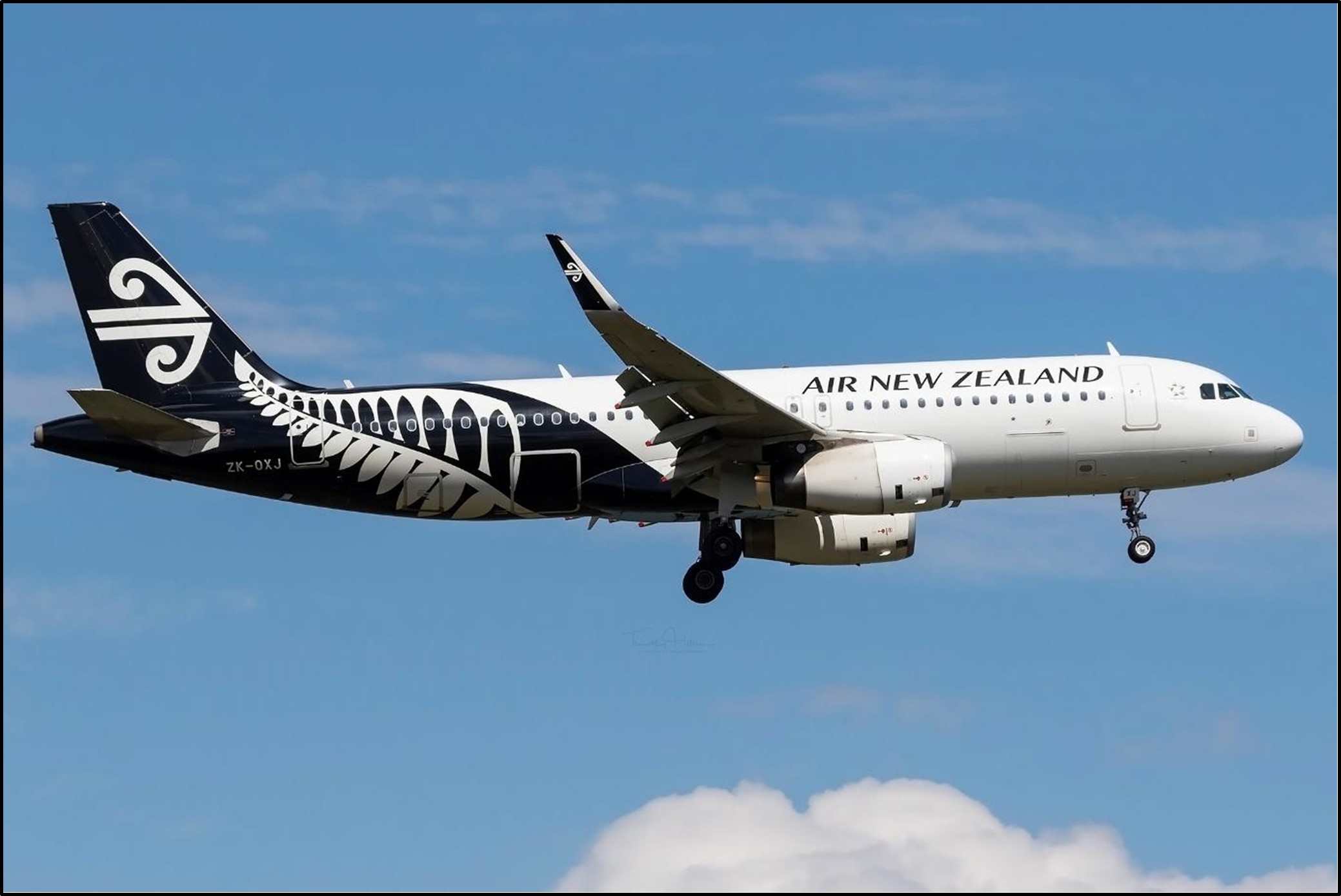
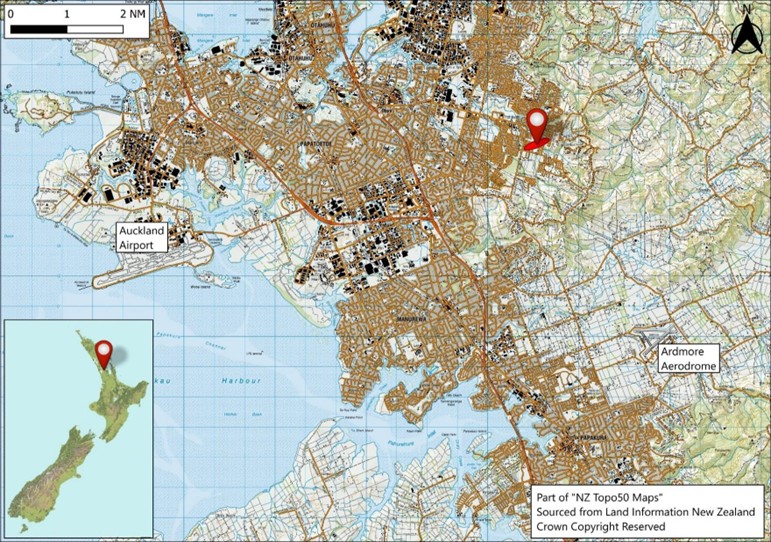
What happened
- In the early evening of 2 April 2024, the crew of an Air New Zealand Airbus A320 reported seeing what they described as a drone while at 2000 feet on the final approach for runway 23L at Auckland.
- As a result of the drone sighting, and for the safety of other aircraft, Air Traffic Control closed that portion of the Auckland airspace for 15 minutes, resulting in delays to other inbound aircraft.
Why it happened
- The use of a drone in controlled airspace and at the altitude reported is contrary to Civil Aviation Rules and, as reflected in this and other reported incidents, such use poses a risk to aviation safety. There was no universal and reliable physical or electronic restriction to stop a drone flying in controlled airspace, so the system was reliant on drone operators knowing and following the rules.
- However, some drone operators either do not know the rules, or are willing to disregard the rules because consequences for non-compliance seldom occur. In this incident, as in many other reported incidents involving drones, it was not possible to identify the drone or its user.
What we can learn
- Until adequate controls are placed on the use of drones, other aircraft, including passenger-carrying aircraft, continue to be at risk of disruption and collision.
- Information and other tools are available to assist operators to operate their drones safely and comply with the Civil Aviation Rules.
Who may benefit
- Drone owners, operators and pilots, manned aviation pilots, Air Traffic Controllers, aerodrome owners, operators and users, local councils, regulators and legislators may benefit from the findings and recommendations in this report.
Factual information Pārongo pono
Narrative
- At about 1815 (New Zealand Daylight Time (Universal Coordinated Time +13 hours) expressed in the 24-hour format) on 2 April 2024, an Airbus A320-232, registration ZK-OXJ, (the aeroplane) operating as flight NZ562 from Christchurch to Auckland was at 2000 feet (ft) above mean sea level (AMSL) on an instrument approach for runway 23 Left (23L) (referenced to the nearest 10 degrees magnetic bearing. Runway 23L is therefore aligned on 230°. The ‘L’ signifies that it is the left runway on 230°) at Auckland when the flight crew reported seeing a drone pass close to their aircraft. The aeroplane was about 7 nautical miles (NM) from the threshold of runway 23L and was inside the Auckland Control Zone.
- The crew both reported that the drone first appeared slightly to right (north) of the aircraft and then passed over the top of the flight deck in very clear sight towards Ardmore to the south. The crew were able to confirm that there was no collision by observing the drone tracking away from the aeroplane.
- The crew described the drone as being “about the size of a duck”, as it partly filled the front windscreen when it was at its closest.
- The pilot immediately reported the drone sighting to the Auckland tower controller, who then closed that segment of airspace for 15 minutes in accordance with the Airways Corporation of New Zealand Limited (Airways) procedures (Manual of Air Traffic Services (MATS) Advisory Circular (AC) Number 13: Part 101 and Part 102 Operations Within Controlled Airspace, Section 5 Unauthorised Operations).
- At the time of this report, there was no universal mechanism in place to identify drone operators or drone pilots in New Zealand, and the drone pilot had not been identified by the Police, the Civil Aviation Authority of New Zealand (CAA), Airways or the Commission.
Aircraft and Personnel information
- The aeroplane involved was an Airbus A320-232, ZK-OXJ, operated by Air New Zealand.
- The flight crew consisted of a captain and first officer. The pilots were both Auckland- based and were both appropriately qualified.
- The flight was the last of four sectors from Auckland to Christchurch and return (two return flights). The first officer was the pilot flying (PF) and the captain was the pilot monitoring (PM) for the final Christchurch to Auckland leg.
Meteorological information
- During interview, the pilots both stated that the weather was suitable for a visual approach from about 2700 ft AMSL, with patchy cloud but no rain. The wind was light and there was excellent visibility.
Drones
- The ubiquitous term ‘drone’ is used across the aviation industry and by the general public to refer to a broad range of devices, encompassing Remotely Piloted Aircraft Systems (RPAS) (also known as unmanned aerial vehicles (UAV)) as well as Autonomous Aircraft Systems and Optionally Piloted Aircraft Systems.
- Drones come in all shapes and sizes, from tiny devices weighing only a few grams through to full-sized aircraft weighing thousands of kilograms. While many consumer drones are basically toys, there are many commercial activities that employ drones of increasingly larger sizes.
- Like any technology, there are low-cost drones with very basic systems right through to very-high-value drones with extremely complex flight management and payload systems. There is continuous development in the technology available to allow for increasingly complex equipment and operations.
- Drone operations in New Zealand are governed by Civil Aviation Rules (CARs) Part 101 (see Intro to Part 101 rules for unmanned aircraft | aviation.govt.nz) and Part 102 (see Intro to Part 102 certification for unmanned aircraft | aviation.govt.nz). Guidance for drone operators and pilots is contained on the CAA website and in a CAA information sheet (see Appendix 1).
- Part 101 provides the baseline rules that govern general drone operations in New Zealand. To provide safe separation between manned aircraft and drones, the rules in Part 101 define where, when and how drones can be operated, while also trying to balance the needs of private and commercial drone operators to use or just enjoy their drone. These rules are more restrictive than Part 102.
- Part 102 permits less-restricted operations by drone operators who have obtained an Unmanned Aircraft Operator Certificate. Drone operators require a certificate if they want to fly an unmanned aircraft outside the restrictions of the Part 101 rules – for example an ‘unshielded operation’ at night, flight over third-party property without prior notification and/or permission, or for a drone that weighs more than 25 kg (CARs Part 101 prohibits the operation of remotely piloted aircraft weighing between 15 kg and 25 kg, unless its construction and operation is done in conjunction with an approved person or organisation defined in Rule 101.202).
- To be able to operate outside the limitations of Part 101 rules, drone operators need to demonstrate how they will manage the risks of their intended activities. They do this by providing the CAA with an exposition showing the hazards and risks they have identified for their operation, and the ways they will mitigate those hazards and risks. Each application is considered on its merit before a Part 102 Unmanned Aircraft Operators Certificate is issued. There are ongoing compliance requirements, and associated costs, to maintain Part 102 certification.
Drones in controlled airspace
- The Part 101 rules allow for drone operations in controlled airspace, with permission from Air Traffic Control (ATC). An exemption to this is a ‘shielded operation’, in which ATC permission is not required.
- Airways, along with CAA and UAVNZ, has created a website and mobile application called Airshare (airshare.co.nz) that gives information on operating a drone near aerodromes and controlled airspace. Airshare allows drone pilots to register their flights and request prior authorisation from ATC to operate unshielded in controlled airspace.
- Another website, Flight Advisor (flightadvisornz.io), has been created by the Royal New Zealand Air Force and Aeropath for logging low-level flights outside controlled airspace. Flight Advisor is available to everyone in the aviation industry, and is typically used by the
- New Zealand Defence Force and agricultural, forestry, airborne emergency medical service and drone operators that are regularly engaged in low-level aerial activities that may overlap with each other.
- For more sensitive regions of controlled airspace (for instance, close to Auckland airport, especially near the approach and departure paths) a drone operator is unlikely to get ATC approval to operate unless they hold Part 102 certification and the operator has a legitimate reason for operating in that area.
- Airways data from the beginning of January 2019 to the end of 2024 show a total of 367 reported airspace incidents involving drones, including 57 in Control Areas (CTA) (see Table 1) with a maximum reported height of 8000 ft AMSL.
- This resulted in a total of 36 delayed or cancelled flights and 5 go-arounds (see Table 2).

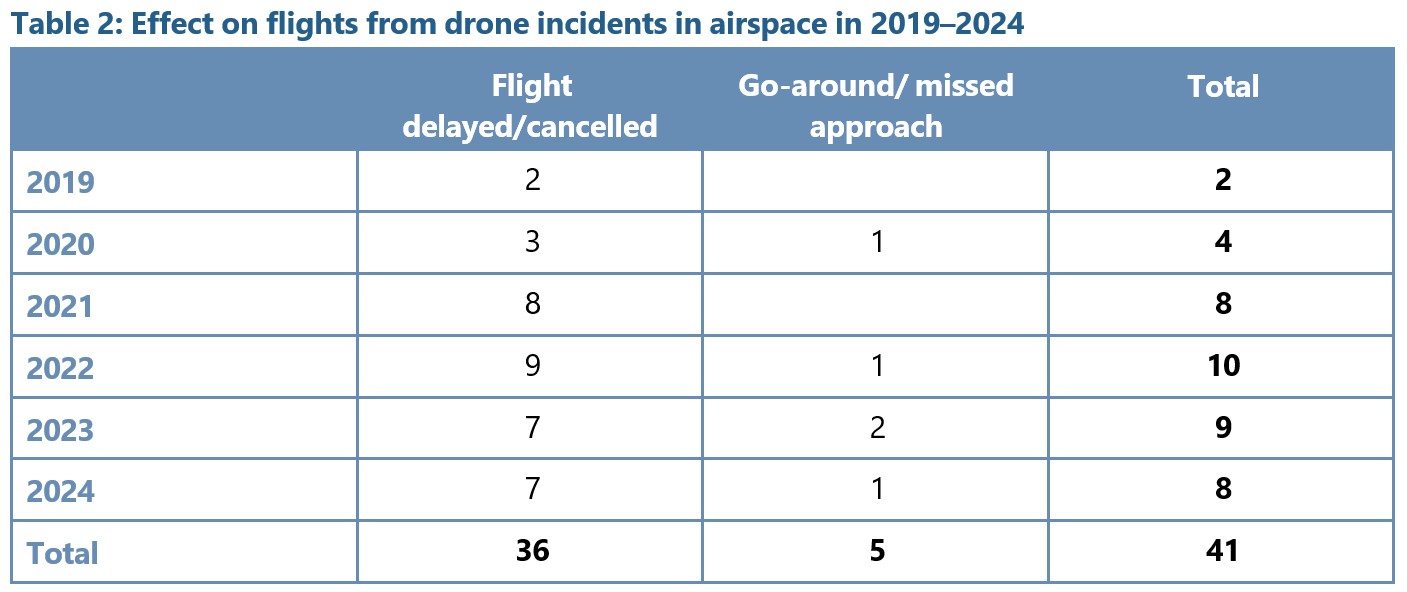
CAA data on drones in controlled airspace
- A request to CAA for reported incidents involving drones returned a total of 5297 incidents from the beginning of 2015 to the end of 2024 (see Figure 3).
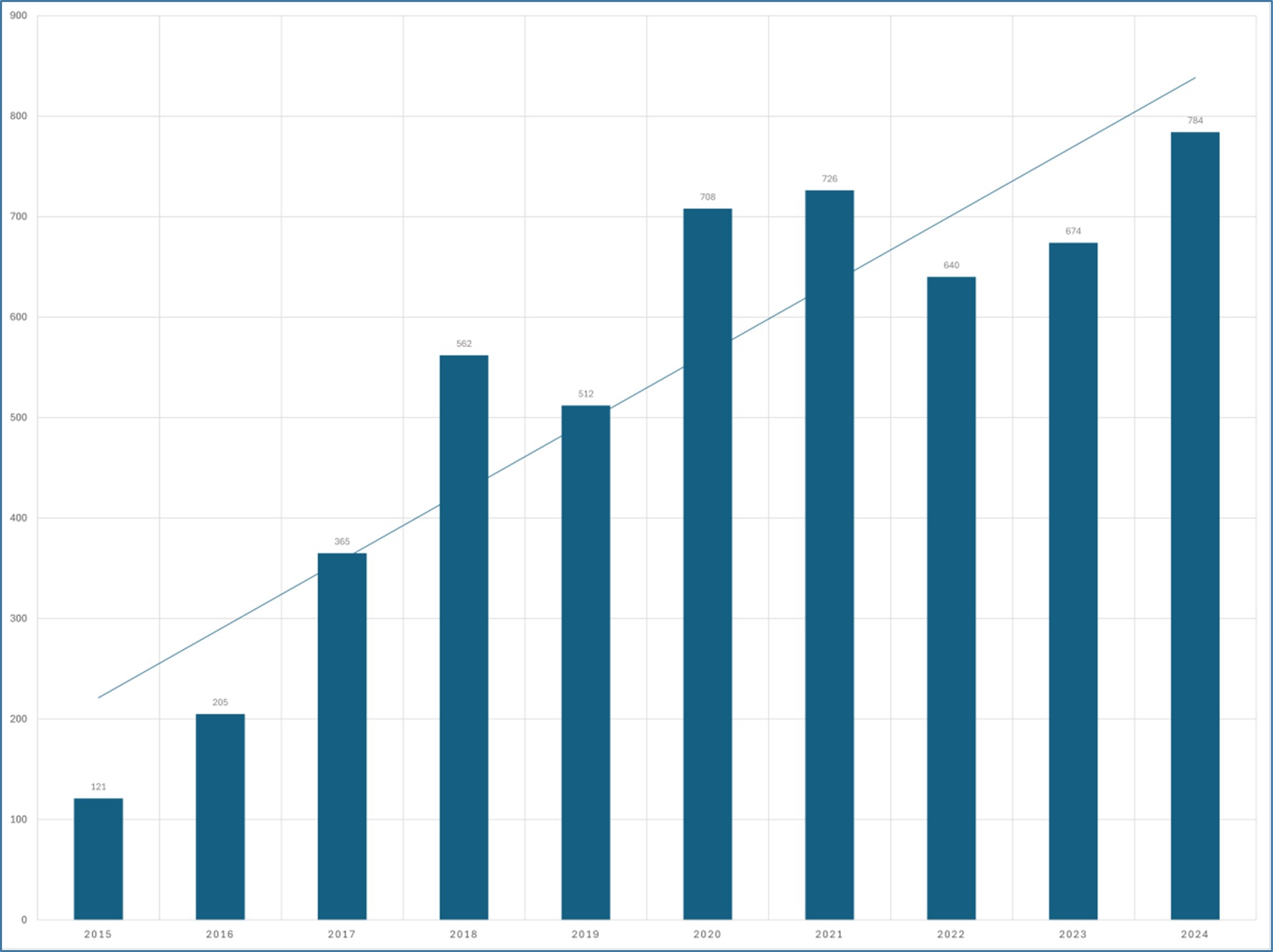
- For a breakdown of incidents by aerodrome (top 20 only) see Table 3. For the distribution around New Zealand from the beginning of 2015 to the end of 2024 (see Figure 4). The format of the data set received is such that a comprehensive analysis of those incidents to identify any more detailed themes would be difficult and has not been undertaken. CAA report that they have not commissioned or produced any formal analysis of trends involving drones/RPAS airspace incidents.
- The number of incidents across all aerodromes, including urban hospital heliports, indicates that there is a systemic issue across the whole of New Zealand and the evidence indicates that it is proportional to the local population density (see Figure 4).
- Of the 5297 reported incidents, the CAA advise that they initiated action in response to 1938 of the incidents. See Table 4 for a breakdown of incidents where the CAA initiated action by aerodrome (top 20 only).


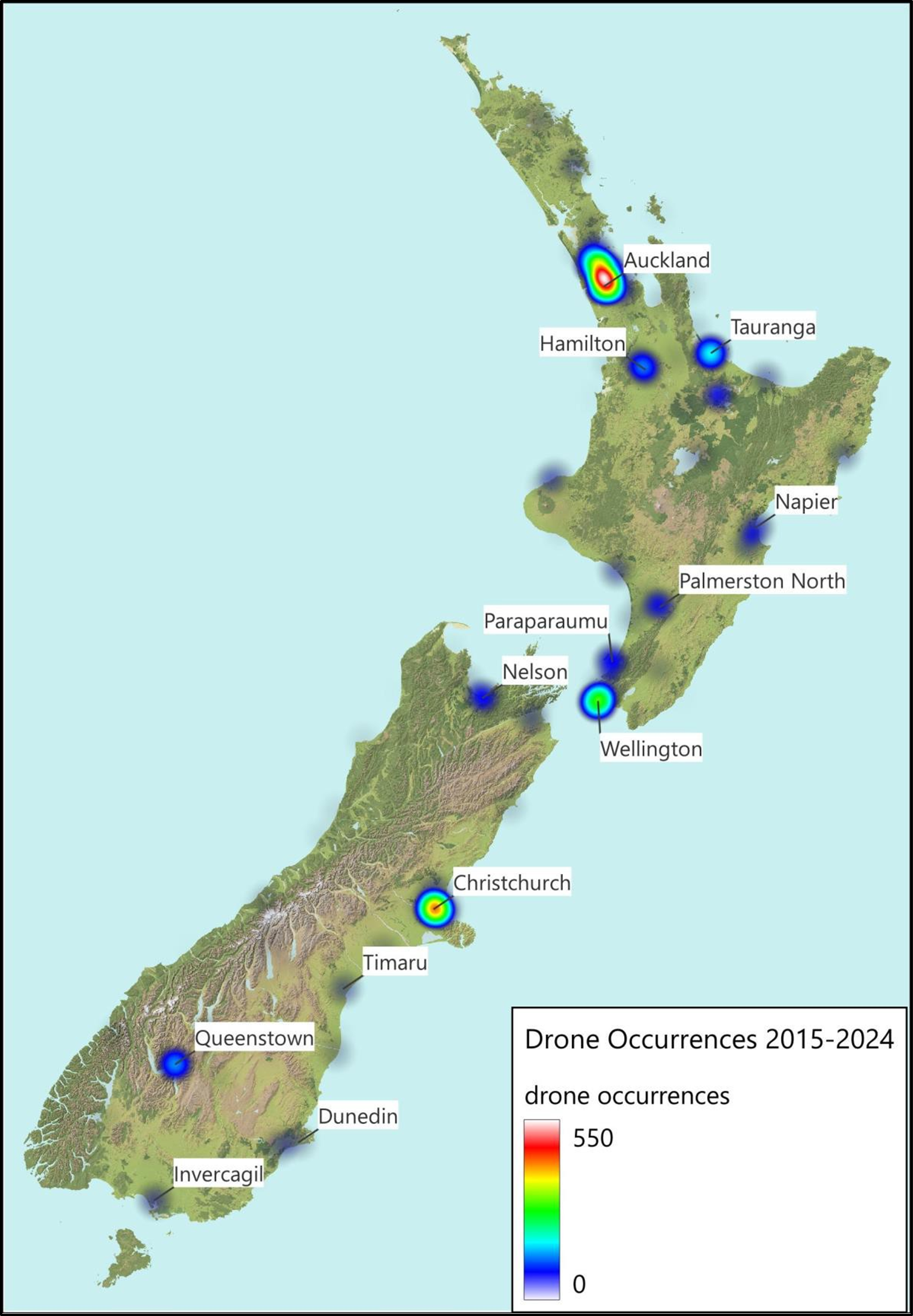
- The CAA was asked to provide information on educational and enforcement activity since the beginning of 2019. Its response in August 2024 included the following information about enforcement activities:
If a RPAS complaint has been assessed as a low risk event, and providing there are no other factors to consider, such as repeat offenders, we adopt an educational approach by sending the RPAS operator or address where the RPAS was operated from, an educational letter. The letter outlines the circumstances of the complaint and provides links to the appropriate rules. The letter reminds them of their obligations and possible enforcement outcomes if they repeat the behaviour.
- The response included the following information about educational activities:
The Authority also conduct pro-active activities to help reduce drone occurrences. These include working with the Real Estate Authority requesting them to remind real estate agents of their obligations when using drones or contracting drone operators to carry-out marketing photographs. We have approached hotel association and rental car companies requesting they place pamphlets about the drone rules (supplied by CAA) in their reception areas and vehicles. This is due to drone complaints involving foreign tourists over the summer months.
The Authority has conducted two campaigns regarding drone safety:
- 2018-2019: Fly the right way: referenced in July/August 2018 Vector
- 2020-2024 Share the skies: was an updated drone safety campaign which highlights six rules drone users must follow to safely Share the Skies.
- An updated response from CAA in February 2025 includes the following information about educational activities:
- Between December 2024 and February 2025 the CAA is running a targeted social media campaign to target new drone operators understanding of the basic rules. So far there’s been over 6,000 people download the new educational brochure.
- A new educational brochure was developed to help operators understand the rules
- DOC and CAA sent a notification to 101/102 users about DOC drone rules and permits
- CAA communicated with the Rental Vehicle Association and got messaging in their newsletter
- Stuff reported on the CAA’s media release that launched the social media campaign
- CAA enforcement action (CAA issued infringement fees (fines) which ranged from $500 to $3000) from the beginning of 2019 to the end of 2024 was reported as:
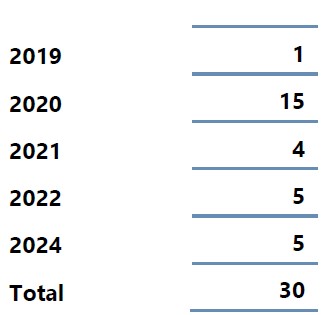
- CAA educational activity from the beginning of 2019 to the end of 2024 was reported as:
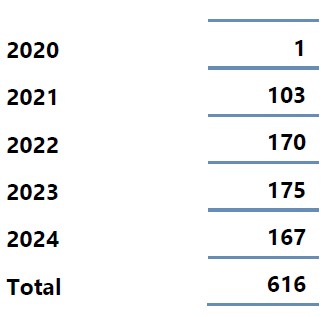
NZ Government drone-integration efforts and overseas efforts
- The CAA is a member of the Joint Authorities for Rulemaking on Unmanned Systems (JARUS) (jarus-rpas.org), a group of 68 countries as well as the European Union Aviation Safety Administration (EASA) and the European Organisation for the Safety of Air Navigation (Eurocontrol). The JARUS website states the objective of JARUS is:
… to provide guidance material aiming to facilitate each Authority to write their own requirements and to avoid duplication of efforts. If this harmonised guidance is endorsed by the Authorities, this will facilitate the validation process of foreign certificates/approvals. - In 2021 the Ministry of Transport (MoT) released the Discussion Document: Enabling Drone Integration (Ministry of Transport, 2021a) and an associated summary document (Ministry of Transport, 2021b) as part of seeking feedback on a proposed approach to enhance the New Zealand drone regulatory regime and enable the integration of drones into the civil aviation system.
- In the summary document, the short-term benefits identified were:
- fewer illegal airspace incursions
- fewer personal injuries and property damages
- more effective and timely enforcement, resulting in lower investigation costs
- improved confidence and acceptance of drones
- The risks were summed up as:
If we do not act now, we run the risk of making it more difficult to catch-up to where we need to be. The existing problems would not be solved and drone integration would simply not happen. It is important to keep up with the evolution and growth of the drone sector and to ensure our regulations remain effective. - Subsequently, for Budget 2022, a draft paper entitled ‘Funding of emerging aviation technologies and drone integration in New Zealand’ (Ministry of Transport, 2023, p. 6) (Draft Cabinet Paper contained within an Official Information Act 1982 response from the Ministry of Transport) was prepared for the Cabinet Economic Development Committee.
- Recommendations in that paper included:
- basic Operator Accreditation
- registration of drones over 250g
- remote identification of RPAS
- mandatory use of geo-awareness technology
- The CAA advised the Commission that the Enabling Drone Integration programme did not progress, and that the reasons why were unknown to the CAA.
- The CAA also advised the Commission that without appropriate approval and funding they cannot progress these initiatives.
- The MoT was asked for an update on any drone integration work. Their response on 11 July 2024 was:
The information on the Ministry website (see (Ministry of Transport, n.d.)) is current.
The previous Government did not make any decisions regarding the proposed enabling drone integration package. The Ministry is in the process of briefing the new Government on a potential drone work programme. There is currently no timetable of when this work will recommence. Note: the final package may differ from what was consulted on. - Budget 2024 records the return of contingency funding that had been allocated for drone integration (New Zealand Government, 2024, p. 103).
Analysis Tātaritanga
Introduction
- As consumer electronic technology has developed, drones have become more accessible to the general public, resulting in a substantial increase in the number of drones being operated in New Zealand. The number and frequency of incident reports involving drones operating in controlled airspace without authorisation has also increased. This occurrence was classified as an ‘air proximity’ or AIRPROX event as described by the International Civil Aviation Organization (ICAO).
- There have been examples of reported collisions between crewed aircraft and drones occurring in recent years in New Zealand, generally resulting in superficial damage to the aircraft concerned. However, because of the lack of physical remains of a drone, or any record of the existence of a drone in close proximity to the aircraft in question, it cannot always be proven beyond doubt that the damage to an aircraft was caused by a drone rather than some other object, such as a bird.
Effect of collision between drone and a manned aircraft
- Many common drones are similar in size and weight to a bird. The effects of bird strikes on aircraft have been extensively studied and, as a result, aircraft are designed to mitigate the effects of bird strikes on the airworthiness of the aircraft. Therefore, there has been a tendency for people to assume that a collision between a drone and an aircraft would be similar to that of an individual bird strike.
- The 2013 report Potential damage assessment of a mid-air collision with a small UAV (Radi, 2013) shows that there are some significant and important differences between bird strikes and a collision with a drone.
- Modern drones, including the popular ‘quadcopter’ design, can travel at considerable speeds, often more than 70 kph, and can typically weigh close to 2 kg. Birds, usually considered to be a nominally solid object, tend to behave more like a fluid during a high-speed impact (Gerardo, et al., 2017, p. 23). Drones on the other hand generally have many frangible parts around a solid core that consists of the battery and main structural components and sometime the payload. Drones are often powered by lithium-ion polymer batteries, which if damaged or subjected to excessive heat can generate intense fire. This is the reason there are restrictions around transporting lithium-based batteries onboard aircraft (Travelling with batteries | aviation.govt.nz). However, it remains unclear how the batteries in drones will react following a collision with an aircraft (Moore, 2017; Civil Aviation Authority (UK), 2018, p. 19).
- The US Federal Aviation Administration (FAA) has established a Centre of Excellence for Unmanned Aircraft Systems, also known as the Alliance for System Safety of UAS through Research Excellence (ASSURE) (assureuas.org). This has a broad range of completed and ongoing research projects into the effects of drones on the many different aspects of the aviation industry. These projects include airborne-collision severity-evaluation studies for different types and sizes of aircraft and aircraft components.
New Zealand regulatory environment
- Civil Aviation Rule Part 101 applied to all drone pilots, from individual recreational users through to large commercial operations, to protect manned aviation as well as the general public from the dangers drones might present.
- Aviation is a global activity; all countries with mature aviation regulatory environments experience the same challenges. No country is unique in the challenges to integrate drones into their national airspace system.
- New Zealand is able to benefit from the experiences of other countries that have already progressed the integration of drones into their airspace system. For example, EASA, the FAA and Transport Canada all require pilot training and certification, drone registration and some geo-location/awareness. Table 5 outlines the minimum requirements for basic (entry-level or recreational) users. As operations become more complicated, these requirements generally become more stringent. Some of these requirements were included in the 2022 proposals.
- On 24 September 2024, Vertical Aviation International (VAI) put out a position paper on UAS BVLoS operations (Vertical Aviation International, 2024). A key takeaway from that document, because of the overlap with current aviation practices, especially in controlled airspace and in low-level flight, is the call to fully integrate drones into the current aviation system, rather than treating drones as a separate or special case. This would have the safety benefit of having all aviation participants operating to the same rules and procedures.
- VAI highlighted that visual conspicuity is not enough as the target may be very small, and that one (or both) aircraft may not have the ability to detect the other aircraft visually. VAI made the following statements:
VAI recommends maximum conspicuity—visual, electronic, or otherwise—for all aircraft.
a. VAI recognizes the challenges associated with visually detecting aircraft as small as some UAS, particularly at low altitudes. As such, VAI believes it appropriate for UAS operators to maximize the conspicuity of their platforms.
b. VAI recognizes the challenges associated with some UAS detecting manned aircraft that may be, or may not be, electronically conspicuous. As such, VAI believes it appropriate for manned aircraft operators to maximize the conspicuity of their platforms where reasonable and possible.
c. VAI supports technical solutions to fill these gaps wherever possible.
- While the VAI position paper was primarily targeted at the FAA, the points made have merit for all regulatory bodies attempting to integrate drones into the current aviation system.
Drone incursions in controlled airspace
- The problem of unauthorised drone activity in controlled and other restricted airspace is not unique to New Zealand, with similar trends being reported internationally with increasing regularity.
- There is an apparent increase in drone airspace-infringement incidents being reported, although whether this is because of an increase in the number of infringements, or because of a greater awareness of the threat that drones present to manned aircraft is unclear.
- Neither Part 101 nor Part 102 allows a drone to be in close proximity to an aircraft in controlled airspace without the knowledge of, and permission from, ATC.
- A drone reportedly at 2000 ft in near proximity to a commercial airliner on approach into Auckland, New Zealand’s busiest airport, like many of the other incidents reportedly involving drones, presents a risk to transport safety.
- In this particular incident:
3.17.1. There was no ATC notification or authorisation for a drone operation as reported
3.17.2. The only way for the aircrew to have seen a drone close to their aircraft in controlled airspace was for the drone pilot to be in breach of the rules, either intentionally or through ignorance of the rules and the consequences of their actions
3.17.3. It is virtually certain that an average consumer-sized drone flying at 2000 ft AMSL would not be visible to the naked eye of the drone pilot and would therefore be operating BVLoS. This would be contrary to CAR Part 101.209, which requires visual line of sight operation. BVLoS operations require CAR Part 102 certification. It is very unlikely that an operator holding certification would have operated a drone in the manner reported.
- The following section analyses the circumstances surrounding the event to identify those factors that increased the likelihood of the event occurring or increased the severity of its outcome. It also examines any safety issues that have the potential to adversely affect future operations.
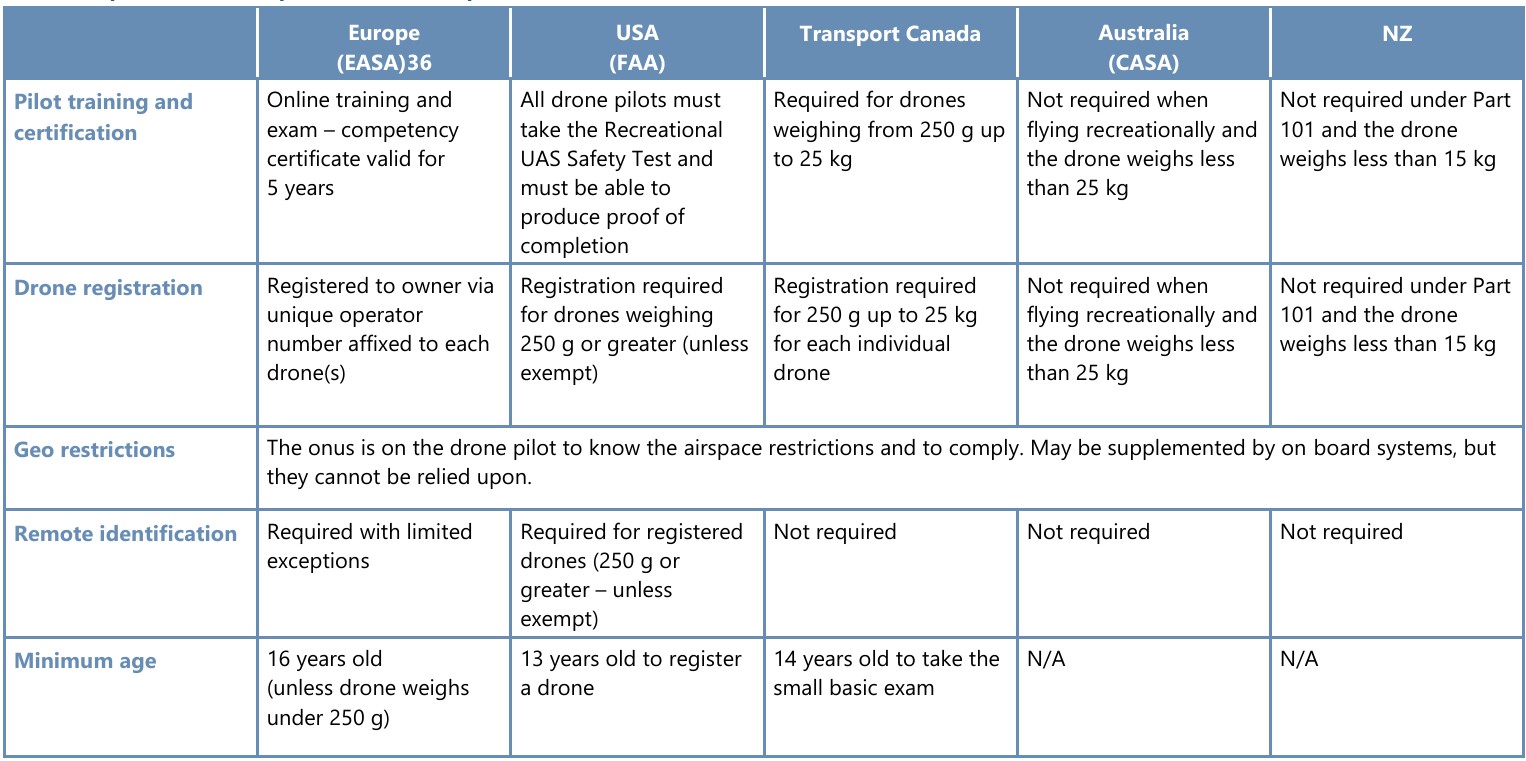
Rule non-compliance
Safety issue 1: Some drone pilots may not be complying with the rules because there are seldom consequences for non-compliance, resulting in potential conflict with manned aircraft.
- A study from Massey University School of Aviation (Henderson & Shelley, 2023) included 2019–2020 survey data that showed:
83.52% of users are fully compliant with the CARs, while 11.64% are non compliant with a single CAR, 3.52% with two CARs, and 1.33% with three or more CARs. The biggest difference between compliance levels was between MFNZ37 members who were more compliant than all other users. This highlights that the model flying club environment introduces social norms that regulate compliance.
Other users more broadly follow ordinary attitudes towards compliance with speed limits when driving, which tend to be driven by social norms and legitimacy rather than instrumentalist approaches.
This study recommends education around the consequences of non compliance, a re-examination of the rules for legitimacy, and further enforcement action for noncompliance as potential policy initiatives to improve compliance among users.
- Section 40 of the Civil Aviation Act 2023 states that operating an aircraft in a careless manner is an offence, punishable by fines of up to $30,000 for individuals and fines of up to $100,000 in the case of a company.
- Section 41 of the Civil Aviation Act 2023 prohibits operating, maintaining, servicing or performing any act relating to aircraft, aerodromes, aeronautical products or aviation related services in a manner that causes unnecessary danger to any other person or to any property. Offences are committed regardless of whether the danger was known, imposing fines of up to $150,000 for individuals and $1.5 million for any other person. Higher penalties apply for intentional or reckless endangerment including up to 5 years' imprisonment or fines of up to $300,000 for an individual and a fine up to $3 million for a company.
- Section 316 of the Civil Aviation Act (2023) has given the New Zealand Police (the Police) new powers in relation to drones, including the power to seize, detain or destroy an unmanned aircraft that may be in breach of the Act, or could be a danger to people or property.
- While those fines can be significant, the enforcement powers will enable the Police to make attempts to remove the danger; the fines and powers have little value if the operator of the drone cannot be identified for the Police (or regulator) to take educational or enforcement action with the party concerned. So the deterrent value is likely to be limited in practical application.
- To increase the perceived or actual consequences of non-compliance, and therefore very likely increase compliance with the rules, there are a number of complementary steps that can be implemented, including:
- operator licencing/accreditation
- registration of drones
- electronic conspicuity/remote identification of drones
- geo-fencing or geo-location awareness
- There are challenges to implementing these measures, including the cost to do so and who should pay. There is also the challenge of retrospectively trying to bring in requirements that current participants, and hardware, may not currently meet. While these issues can be challenging, they should not be insurmountable and there is precedent both within the aviation sector and in other similar regulated sectors.
Rule awareness
Safety issue 2: Some drone pilots may not be complying with Civil Aviation Rules because they are unaware of those Rules and how they apply to them, resulting in potential conflict with manned aircraft.
- A 2020 Colmar Brunton survey on behalf of CAA, MoT and the Ministry of Business, Innovation and Employment (MBIE)38estimated that:
Recreational drone users:
- there were 271,121 recreational drone users
- there were 156,610 drones used for recreational purposes
- 25 per cent of recreational users had very little or no idea of the rules about drone use
- 1 in 5 recreational drone flights may occur in restricted airspace without permission and unshielded
Commercial drone users:
- there were 15,322 drones used for commercial purposes
- there were 7,939 businesses using drones
- 10 per cent of commercial users had very little or no idea of the rules about drone use
- 1 in 5 commercial drone flights may occur in restricted airspace without permission and unshielded
- As there are no records of drone ownership, these numbers were an estimate only and at the time of this report, were already over four years out of date.
- There is no restriction on drone ownership in New Zealand, other than restrictions on the weight of the drone. Anyone, of any age, may operate one under Part 101. CAR Part 101.215 states (a) A person must not operate a remotely piloted aircraft, a control-line model aircraft or a free-flight model aircraft with a gross mass of more than 25 kg; (b) A person must not operate a remotely piloted aircraft with a gross mass of between 15 kg and 25 kg unless the aircraft, and any modification made to it, is (1) constructed under the authority of, or inspected and approved by, an approved person or organisation defined in Rule 101.202; and (2) operated under the authority of an approved person or organisation defined in Rule 101.202.
- Manned aviation has traditionally had many barriers to entry and by necessity is a heavily regulated activity. Now there are participants operating in the same airspace, with virtually no barriers to entry and an acknowledged major lack of knowledge and understanding of the rules, which potentially poses a direct threat to the safety of the travelling public.
Preventative controls
Safety issue 3: In the event of the loss of control of a drone, there are no mandatory controls to prevent conflict with manned aircraft.
- There is no requirement in CARs Part 101 that requires geo-awareness or geo-fencing technology to be built into drone systems, nor is there a requirement for drone pilots to use the technology if it is available. 3.31.
- Drone pilots are required to be aware of local airspace and the restrictions associated with it. While there are tools available that assist with that awareness (such as Airshare, Flight Aware and some drone control software), the onus is on the drone pilot to be proactive about avoiding airspace incursions and conflict with manned aircraft.
- It is not known whether the drone reported in this incident included such systems or, if so, whether they were in operation at the time. However, a drone with correctly operating geo-fencing software installed would not have been able to be at approximately 2000 ft AMSL on the approach to runway 23L at Auckland, regardless of whether it was caused by a lack of knowledge of the Rules, an intentional act by the operator, or by a loss of control resulting in a flyaway situation.
Summary
- The steps listed in paragraph 3.24 to promote compliance with the rules reflect the current aviation system, as demonstrated in the following table:

- This leads to the observation that while drones may appear to be different from traditional aviation participants, they share much of the same airspace as traditional aircraft. Helicopters and agricultural aircraft often operate legitimately below 500 ft above ground level, which brings them in direct conflict with drones that are legally permitted to operate up to 400 ft above ground level and are, as reported in this incident, capable of operating at much higher altitudes.
- In airspace that is subject to ATC management, all equipment capable of flight should be subject to ATC by the single agency responsible for that airspace, under a unified set of rules.
- Significant progress has already been made in order to integrate drones into the New Zealand aviation system. The discussion documents, papers and feedback from interested parties highlight the importance of prompt action and the risk to manned aviation if steps are not taken to successfully integrate drones and drone pilots into the wider aviation system.
- Analysis of reported incidents of drone incursions into controlled airspace and close proximity events show that both are continuing to increase and will almost certainly continue to do so unless prompt action is taken.
Findings Ngā kitenga
- The flight crew of an Airbus A320, very likely witnessed a drone in close proximity to their aeroplane while on approach to runway 23L at Auckland.
- Air traffic control had not authorised any drone operations in the airspace around Auckland at the time of the incident; there should not have been any drones operating within 4 km of Auckland.
- The drone pilot’s intentions are unknown as neither they nor the drone itself could be identified.
- It is almost certain that the drone did not have a functioning operating mechanism in place to restrict access to controlled and/or restricted airspace.
Safety issues and remedial action Ngā take haumaru me ngā mahi whakatika
General
- Safety issues are an output from the Commission’s analysis. They may not always relate to factors directly contributing to the accident or incident. They typically describe a system problem that has the potential to adversely affect future transport safety.
- Safety issues may be addressed by safety actions taken by a participant. Otherwise, the Commission may issue a recommendation to address the issue.
Safety issue 1: Some drone pilots may not be complying with the rules because there are seldom consequences for non-compliance, resulting in potential conflict with manned aircraft.
- No action has been taken to address this safety issue. Therefore, the Commission has made a recommendation in Section 6 to address this issue.
Safety issue 2: Some drone pilots may not be complying with Civil Aviation Rules because they are unaware of those Rules and how they apply to them, resulting in potential conflict with manned aircraft.
- On 7 February 2025 the Civil Aviation Authority advised the Commission they had taken the following safety actions to address this issue:
- Between December 2024 – February 2025 the CAA is running a targeted social media campaign to target new drone operators understanding of the basic rules. So far there’s been over 6,000 people download the new educational brochure
- A new educational brochure was developed to help operators understand the rules
- DOC and CAA sent a notification to 101/102 users about DOC drone rules and permits
- CAA communicated with the Rental Vehicle Association and got messaging in their newsletter
- Stuff reported on the CAA’s media release that launched the social media campaign
- The Commission welcomes the safety action to date. However, it believes more action needs to be taken to ensure the safety of future operations. Therefore, the Commission has made a recommendation in Section 6 to address this issue.
Safety issue 3: In the event of the loss of control of a drone, there are no mandatory controls to prevent conflict with manned aircraft.
- No action has been taken to address this safety issue. Therefore, the Commission has made a recommendation in Section 6 to address this issue.
Recommendations Ngā tūtohutang
General
- The Commission issues recommendations to address safety issues found in its investigations. Recommendations may be addressed to organisations or people, and can relate to safety issues found within an organisation or within the wider transport system that have the potential to contribute to future transport accidents and incidents.
- In the interests of transport safety, it is important that recommendations are implemented without delay to help prevent similar accidents or incidents occurring in the future.
Key lessons Ngā akoranga matua
- Drones are not permitted to operate in controlled airspace without permission from Air Traffic Control.
- Drone pilots need to be familiar with, and abide by, the rules in CARs Part 101, in particular when operating within a 4 km radius of an aerodrome’s boundaries.
- Unauthorised and non-compliant use of drones continue to be a safety risk to other aircraft operations.
- Lack of rule awareness and non-compliance are a major factor in reported drone incidents.
- New Zealand’s regulatory environment is not in line with many other countries in ensuring safe drone operations.
- Without being able to identify the drone, pilot or operator, the ability to investigate and learn key safety lessons from drone incidents and accidents is restricted.
Data summary Whakarāpopoto raraunga
Details
latitude: 36° 58.2‘ south
longitude: 174° 56.4´ east
Conduct of the inquiry Te whakahaere i te pakirehua
- On 3 April 2024, the Civil Aviation Authority notified the Commission of the occurrence. The Commission subsequently opened an inquiry under section 13(1) of the Transport Accident Investigation Commission Act 1990 and appointed an Investigator-in-Charge.
- Following the occurrence, the Commission’s investigation team interviewed the flight crew. The Commission also obtained Air Traffic Control recordings of the flight and weather data.
- Between May and October 2024, the investigation team met with representatives of industry, the Police and New Zealand Defence Force drone experts.
- On 12 June 2024 the investigation team met with representatives of the Civil Aviation Authority.
- On 27 February 2025 the Commission approved a draft report for circulation to seven interested parties for their comment.
- Three interested parties provided a detailed submission and four interested parties replied that they had no comment. Any changes as a result of the submissions have been included in the final report.
- On 30 April 2025, the Commission approved the final report for publication.
Glossary Kuputaka
- Air proximity
- A situation in which, in the opinion of a pilot or air traffic services personnel, the distance between aircraft as well as their relative positions and speed have been such that the safety of the aircraft involved may have been compromised. (ICAO Doc 4444: PANS-ATM). There are 4 available classification categories: A. Risk of collision B. Safety not assured C. No risk of collision D. Risk not determined
- Aviation related concern
- A voluntary reporting of aviation matters that are not accidents or incidents
- Control areas
- A controlled airspace extending upwards from a specified limit above the earth
- Control Zone
- A block of controlled airspace extending from the surface of the earth to a specified upper limit. The upper limit of a control zone is usually the lower limit of a controlled area extending further upwards.
- Drone
- The generic term used when referring to a Remotely Piloted Aircraft System (RPAS), an Unmanned Aerial Vehicle (UAV) or an aircraft in operation without a pilot onboard.
- MBZ
- Mandatory Broadcast Zone
Citations Ngā tohutoru
Civil Aviation Authority (UK). (2018, January 9). CAP1627: Drone Safety Risk: An assessment. Retrieved from Civil Aviation Authority (UK).
Gerardo, O., Thomas, L., Gomez, L., Espinosa de los Monteros, J., Baldridge, R. J., Zinzuwadia, C., . . . Jayakody, N. (2017). UAS Airborne Collision Severity Evaluation: Summary of Structural Evaluation, Volume 1, p. 23. United States of America Federal Aviation Administration, Centre of Excellence for UAS Research. Retrieved from assureuas.org/projects/uas-airborne-collision-severity-evaluation
Henderson, I. L., & Shelley, A. (2023, January 16). Examining unmanned aircraft user compliance with Civil Aviation Rules. Transport Policy (133), 176–185. Retrieved July 2024, from sciencedirect.com/science/article/abs/pii/S0967070X23000100?via%3Dihub
Ministry of Transport. (2021a, April 6). Enabling Drone Integration. Retrieved from Ministry of Transport: https://www.transport.govt.nz/assets/Uploads/Discussion/EnablingDroneIntegration.pdf
Ministry of Transport. (2021b, April 6). Enabling Drone Integration, Executive Summary. Retrieved from Ministry of Transport: https://www.transport.govt.nz/assets/Uploads/Discussion/SummaryEnablingDroneIntegration.pdf
Ministry of Transport. (2023, Feb 27). Official Information Act response. Retrieved from Ministry of Transport: https://www.transport.govt.nz/assets/Uploads/EmergingTechnologiesUnit.pdf
Ministry of Transport. (n.d.). Drones in New Zealand. Retrieved March 07, 2025, from Ministry of Transport.
Moore, J. (2017, November 29). Drone collisions with aircraft modeled. Retrieved from Aircraft Owners and Pilots Association.
New Zealand Government. (2024, May 30). Budget 2024: Summary of Initiatives. Retrieved from Budget 2024.
Radi, A. (2013, April). Potential damage assessment of a mid-air collision with a small UAV. Civil Aviation Safety Authority / Monash University. Retrieved from sUASNews: https://www.suasnews.com/wp-content/uploads/2016/04/CASA-Publication-2 potential-damage-assessment-mid-air-collision-small-rpa.pdf
Vertical Aviation International. (2024, September 24). VAI Position Statement on UAS Beyond Visual-Line-of-Sight (BVLOS). Retrieved from Vertical Aviation International.
Appendix 1. CAA drone flying guidance
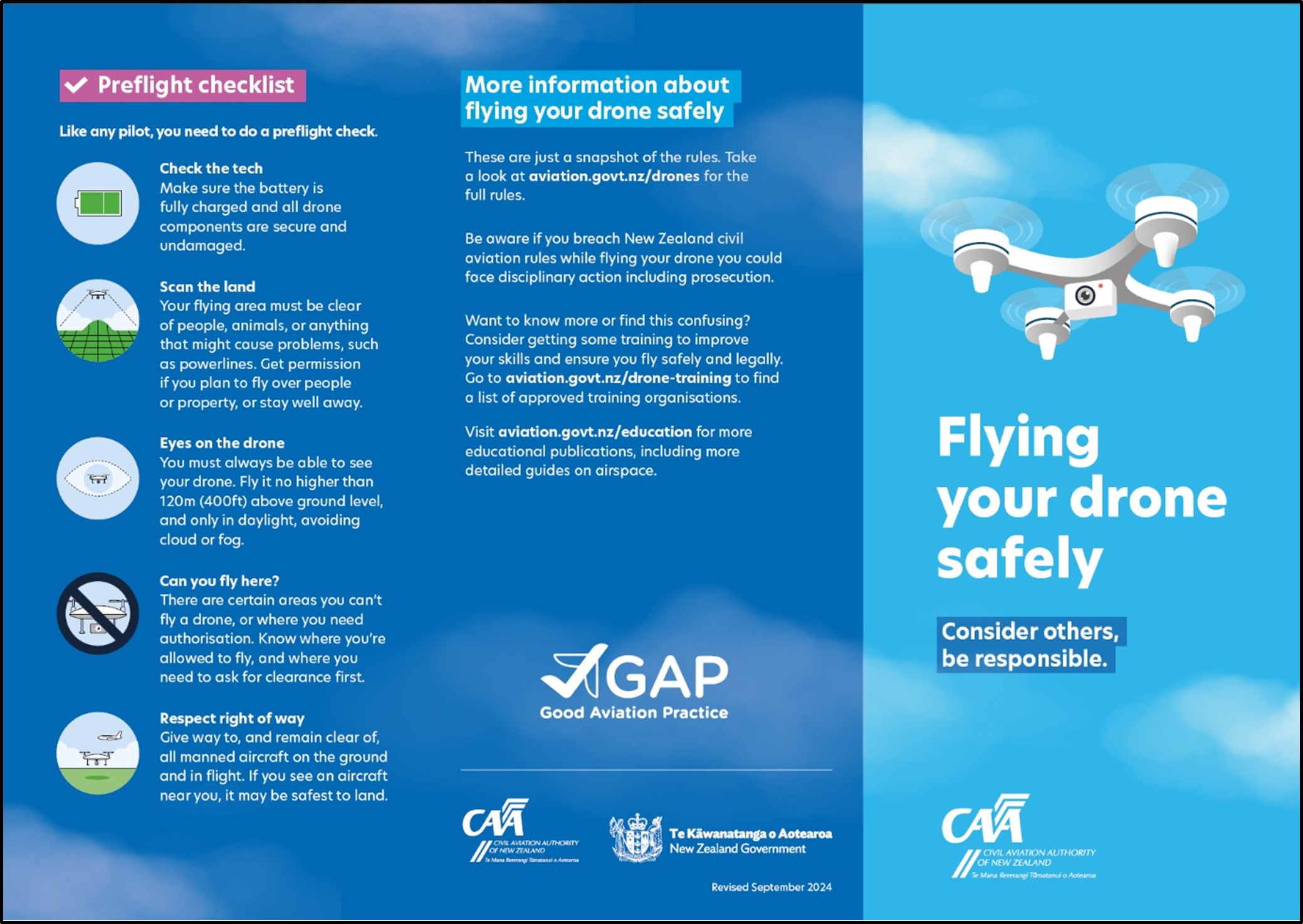
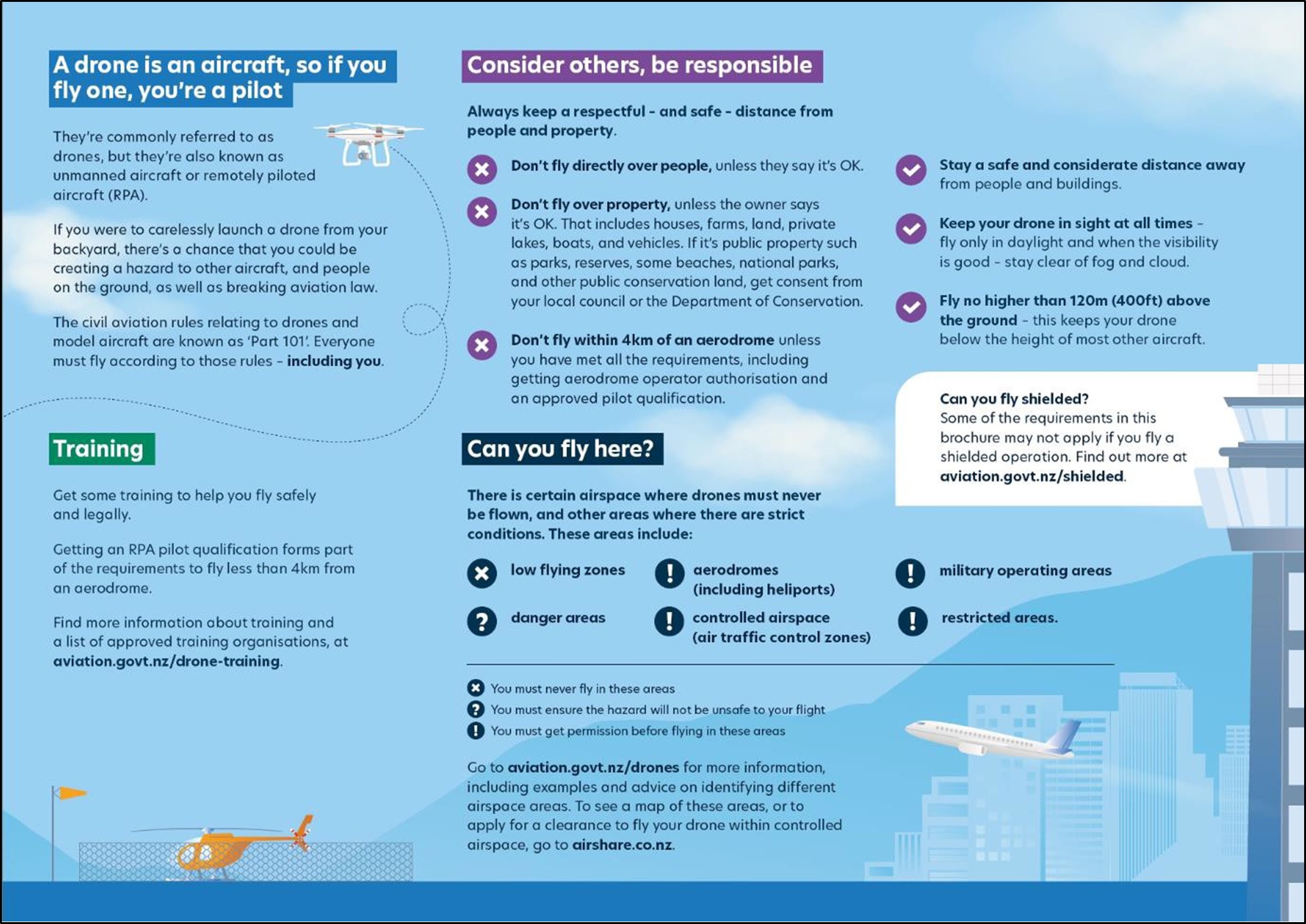
Related Recommendations
On 14 May 2025, the Commission recommended that the Ministry of Transport and the Civil Aviation Authority of New Zealand, in consultation with stakeholders, work to fully integrate drones into the aviation system and develop appropriate rules and standards, to reflect technology developments and relevant international best practices.
